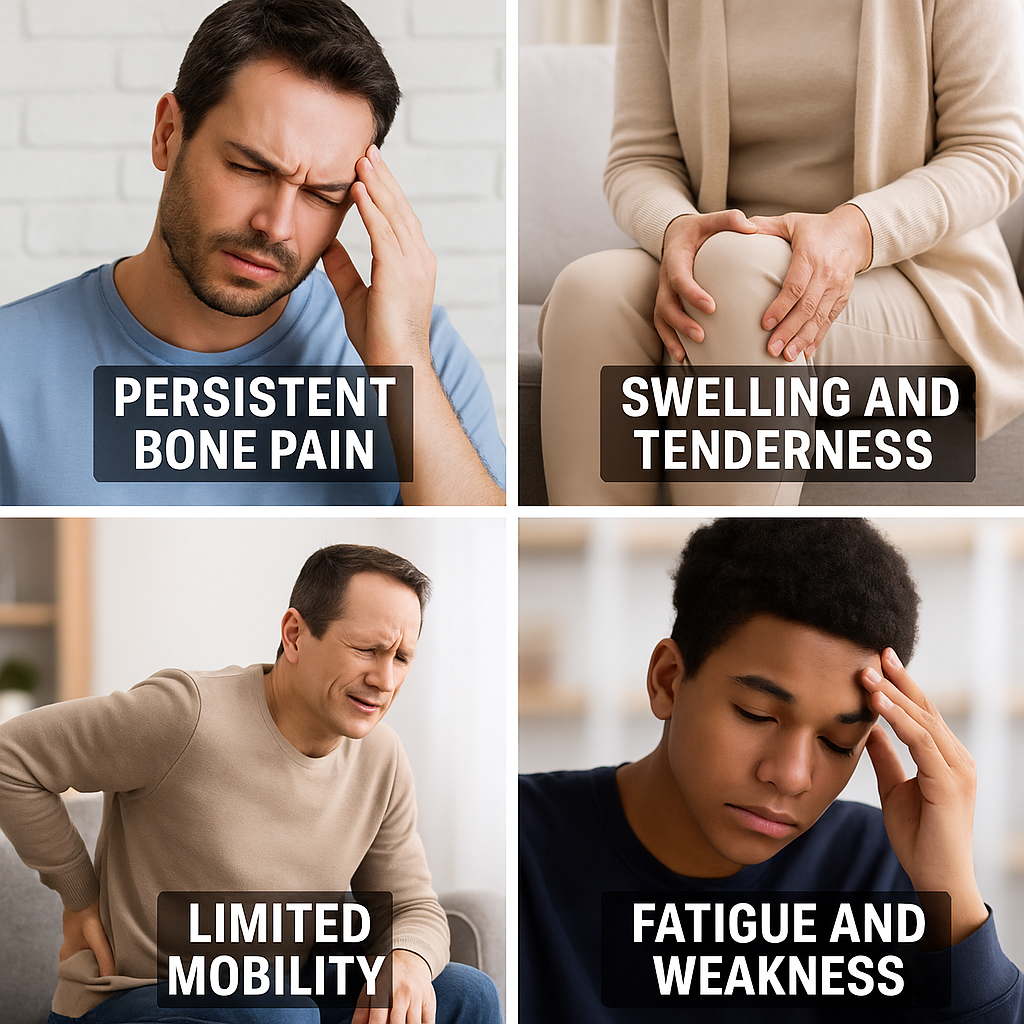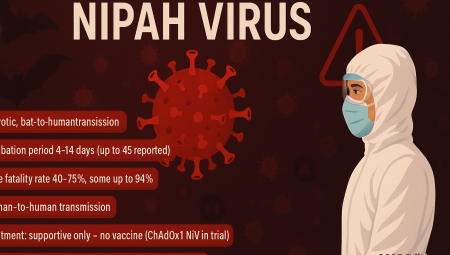Bone cancer is a rare but serious condition that can affect people of all ages. Understanding the early and late symptoms of bone cancer is essential for timely diagnosis and effective treatment. This guide dives deep into everything you need to know about the symptoms of bone cancer, including how they differ by age, type, and tumor location.
Understanding Bone Cancer
What is Bone Cancer?
Bone cancer refers to the abnormal growth of cells within the bones, forming a mass known as a tumor. These tumors may be benign (non-cancerous) or malignant (cancerous). Malignant bone tumors are dangerous because they can destroy healthy bone tissue and spread to other parts of the body.
Types of Bone Cancer
There are several types of primary bone cancer:
-
Osteosarcoma – Most common in teenagers and young adults.
-
Chondrosarcoma – Typically found in adults and arises from cartilage.
-
Ewing’s Sarcoma – Often diagnosed in children and young adults.
Who is Most at Risk?
While anyone can develop bone cancer, certain risk factors increase the chances, including:
-
Genetic syndromes (e.g., Li-Fraumeni syndrome)
-
Radiation exposure
-
Paget’s disease of bone
-
Prior bone injuries or chronic inflammation
Early Signs of Bone Cancer
Persistent Bone Pain
One of the earliest and most common symptoms of bone cancer is constant, dull bone pain. It may begin as occasional discomfort, often mistaken for muscle strain or arthritis, but it gradually worsens over time and doesn’t go away with rest.
Swelling and Tenderness
Swelling near a bone or joint could be a sign of a growing tumor. The skin might appear red or feel warm to the touch, and the area becomes sensitive or painful, especially with movement.
Limited Mobility
If a tumor develops near a joint, it can restrict motion, making it hard to walk, lift objects, or perform everyday tasks.
Progressive Symptoms to Watch For
Fatigue and Weakness
As the disease progresses, extreme tiredness becomes more noticeable. This is often due to the cancer consuming the body’s energy or affecting red blood cell production.
Unexplained Weight Loss
Losing weight without trying can be a sign of many cancers, including bone cancer. This occurs as the body uses more energy to fight the disease.
Fever Without Infection
Some bone cancer patients experience persistent low-grade fevers, even in the absence of infection. This could be due to immune system reactions triggered by the tumor.
Location-Based Symptoms
Symptoms in Arms and Legs
Tumors in long bones such as the femur, tibia, or humerus often lead to:
-
Swelling in the limbs
-
Pain during physical activity or even rest
-
Weakness or reduced function in the arm or leg
-
Increased risk of fractures from minor injuries
Spine and Pelvis Symptoms
Bone cancer in the spine or pelvis can cause:
-
Lower back pain that worsens over time
-
Numbness, tingling, or even paralysis if spinal nerves are affected
-
Discomfort while sitting or walking
Jaw or Skull Signs
While rarer, bone cancer can develop in facial bones, causing:
-
Facial asymmetry or swelling
-
Tooth pain or looseness
-
Vision or hearing issues if it spreads to surrounding areas
How Symptoms Differ by Type
Osteosarcoma
This fast-growing cancer often appears in teenagers during growth spurts. It typically presents with:
-
Pain at night or during activity
-
Swelling near the knee or shoulder
-
Limping or difficulty walking
Ewing’s Sarcoma
Common in children and adolescents, Ewing’s Sarcoma may include:
-
Bone pain that doesn’t improve with rest
-
Fever and fatigue
-
A visible lump or mass on the bone
Chondrosarcoma
Seen mainly in adults, this type involves cartilage-producing cells:
-
Gradual onset of pain
-
Increased stiffness in joints
-
A growing, hard mass on the affected area
Symptoms in Children vs Adults
Pediatric Warning Signs
In children, bone cancer symptoms are often confused with:
-
Growing pains
-
Sports injuries
-
Bone bruises or fractures
Key signs to watch include persistent pain, especially at night, and swelling that doesn’t improve over weeks.
Signs in Older Adults
In older adults, bone cancer may mimic:
-
Arthritis or osteoporosis
-
Chronic back or joint pain
-
Muscle strain
A red flag is pain that persists despite medication or physical therapy.
When to See a Doctor
Red Flags That Need Immediate Medical Attention
Contact a healthcare provider if you or your child experience:
-
Persistent or worsening bone pain
-
Swelling or a visible lump
-
Frequent or unusual fractures
-
Fatigue and unexplained weight loss
Timely evaluation can make a critical difference in diagnosis and treatment outcomes.
Diagnostic Pathways
Imaging Tests (X-rays, MRI)
Initial evaluations often start with X-rays to detect abnormal bone structures. MRI and CT scans provide more detail about the tumor size and its spread to nearby tissues.
Biopsy
A biopsy confirms the cancer type and grade by analyzing a tissue sample under a microscope.
Blood Work
While not always definitive, blood tests may detect elevated markers like alkaline phosphatase or lactate dehydrogenase (LDH).
Common Misdiagnoses
Growing Pains
In children, early symptoms may mimic benign growing pains, leading to delays in diagnosis.
Arthritis or Osteoporosis
In older adults, bone cancer is sometimes misdiagnosed as arthritis or osteoporosis, particularly when pain is the dominant symptom.
Sports Injuries
Athletes may assume the pain is from overuse or injury, which can delay proper evaluation.
Symptoms After Metastasis
Spreading to Lungs
When bone cancer spreads to the lungs, patients may notice:
-
Shortness of breath
-
Chronic cough
-
Chest pain
Systemic Symptoms
Advanced cancer might also cause:
-
Night sweats
-
Severe fatigue
-
General weakness
Bone Cancer vs Bone Metastases
Differences in Symptoms
Primary bone cancer starts in the bone itself, while bone metastases occur when cancer from another part (e.g., breast or prostate) spreads to the bone.
Symptoms may overlap, but bone metastases often involve:
-
Widespread pain
-
Multiple affected sites
-
Symptoms of the original cancer
Common Sources of Metastasis
-
Breast cancer
-
Prostate cancer
-
Lung cancer
-
Kidney cancer
Real Patient Experiences
Personal Accounts of Early Warning Signs
Many survivors recall pain that wouldn’t go away, often dismissed at first. In some cases, school athletes noticed a “weird” leg pain during running that turned out to be serious.
How They Discovered It
Some found it after a fracture from a minor fall. Others were diagnosed after months of unexplained swelling or night pain.
Preventive Measures and Awareness
Importance of Early Detection
Bone cancer is treatable, especially when caught early. Knowing the symptoms of bone cancer and acting on them quickly can drastically improve prognosis.
Awareness Campaigns and Screening
Public health initiatives and education can promote earlier diagnosis. Organizations like the American Cancer Society provide valuable resources for early warning signs.
FAQs About Symptoms of Bone Cancer
1. What does bone cancer pain feel like?
It often starts as a dull ache that worsens over time and doesn’t improve with rest.
2. Is bone cancer pain constant or intermittent?
It typically becomes constant as the tumor grows and may intensify at night or during movement.
3. Can bone cancer be mistaken for arthritis?
Yes, especially in older adults. The symptoms can be very similar.
4. How long can you have bone cancer without knowing?
It can go undetected for months, especially if symptoms are mild or mistaken for other conditions.
5. Are bone cancer symptoms different in children?
Yes. In children, symptoms may resemble growing pains or sports injuries.
6. What’s the most common first symptom of bone cancer?
Persistent bone pain is usually the earliest and most noticeable symptom.
Conclusion
Summary of Symptoms
The symptoms of bone cancer range from subtle aches to severe pain, swelling, and mobility issues. Early detection plays a critical role in improving outcomes.
Call to Action for Early Diagnosis
Don’t ignore persistent bone pain or swelling. If symptoms continue for more than a few weeks, consult a healthcare professional for proper evaluation and peace of mind.
🔗 Useful External Link:
American Cancer Society – Bone Cancer Symptoms



